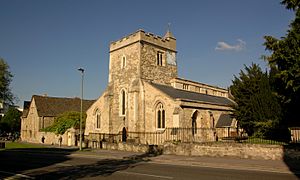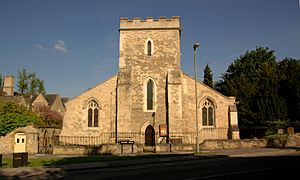St Cross Church, Oxford facts for kids
Quick facts for kids St Cross Church |
|
|---|---|
| Church of St Cross in Holywell | |

St Cross church from the south-west, with Holywell Manor House behind it on the left.
|
|
| Location | Oxford |
| Country | United Kingdom |
| Denomination | Church of England |
| History | |
| Status | Balliol College's historic collections centre (previously parish church) |
| Founded | 9th century |
| Architecture | |
| Functional status | Preserved |
| Heritage designation | Grade I listed (building) Grade II listed (wall) |
| Closed | Closed in 2008; not deconsecrated |
| Specifications | |
| Number of towers | 1 |
| Administration | |
| Parish | Holywell (transferred to University Church of St Mary the Virgin) |
| Diocese | Oxford (formerly) |
St Cross Church is an old church building in Oxford, England. It is located northeast of the city center. This building is now used as a special center for old and important collections. You can find it on St Cross Road, near Manor Road. It is also close to Holywell Manor and Holywell Cemetery.
History of St Cross Church
St Cross Church was once a smaller church connected to St Peter-in-the-East. That church is on Queen's Lane in central Oxford. We don't know the exact year St Cross Church was built. Some people think it was first built around the year 890 by St Grimwald. However, studies in 2009 did not find proof of a church from before the Norman times.
The arch in the church's main area is from the late 1000s or early 1100s. The main part of the church, called the nave, was built around 1160. The tower and side areas (aisles) were added in the 1200s. The top part of the tower was rebuilt in 1464. The north side area was also rebuilt in the mid-1400s. Some of the windows are original Perpendicular Gothic style. Other windows were added later in the Victorian era.
The side areas were rebuilt again in the 1800s. The north aisle was rebuilt in 1839. The south aisle was rebuilt in 1843 by an architect named JM Derick. In 1876, the north aisle was made longer. An organ room and a changing room (vestry) were added. These were designed by HJ Tollit. In 1893, the church was fixed up by EP Warren. New windows were added high up on the walls (clerestory windows). The tower was repaired in 1908.
A famous architect, GE Street, designed a window for the north aisle in 1855. This window has since been moved. St Cross Church is a very important historic building. It is a Grade I listed building. This means it is protected because of its special history and design.
For many years, church services were held once a week. The church officially closed on October 12, 2008.
Holywell Cemetery is behind the church. Many important people are buried there. This includes the composer Sir John Stainer (1840–1901). He was a church warden at St Cross. The clockmaker John Knibb (1650–1722) is also buried there. He was the Mayor of Oxford twice. Sir John Snell, who started the Snell Exhibition scholarships, is also buried in the church.
St Cross as a Collections Center
Over the years, fewer and fewer people attended St Cross Church. In February 2008, the church council decided to let Balliol College use the building. They wanted to create a special place for the College's old collections.
After the church closed in 2008, work began to change the building. It was turned into a Historic Collections Centre for Balliol College. The church has not been officially "un-churched" (deconsecrated). Balliol College has a very long lease (999 years) on the building. This means the main altar area (chancel) can still be used for occasional services.
Some church items were moved. The organ, for example, was sent to a church in Ireland. But memorials and plaques stayed in their original spots. The font (a basin for baptisms) was moved. It was placed on the north side of the chancel steps. This allowed more space in the south aisle for the new collection storage. The church bells are still in the tower. However, they cannot be rung. The city council did not allow them to be removed. The work cost about £3.3 million and finished in 2011.
In May 2008, the Shirley Foundation gave £1 million to Balliol College. This money helped create the Historic Collections Centre at St Cross Church. The center now holds many important items:
- The College's own old records.
- Personal papers from past Masters, Fellows, and students.
- Handwritten books, mostly from the College's medieval library.
- Early printed books, including very old ones (incunabula).
- Other special items that were kept in different places before.
This new center helps the College Library offer more services. One handwritten book (Balliol MS 317) is from around 1170. The College has owned it since 1276. Many medieval books from the College's original library are still there. This collection is very large.
This is the third library at Oxford University to be made from a church. The others are All Saints (for Lincoln College) and St Peter-in-the-East (for St Edmund Hall). Two other libraries were made from old chapel buildings. The Centre has modern facilities for researchers.
St Cross Church has other connections to Balliol College. John Snell, who gave money for scholarships, was buried there in 1679. Two past Masters of Balliol College are buried in the cemetery. They are J. L. Strachan-Davidson and A. L. Smith.
St Cross in Stories
- In the book Busman's Honeymoon, the fictional detective Lord Peter Wimsey marries Harriet Vane. Their wedding happens in St Cross Church on October 8, 1935. This book was written by Dorothy L. Sayers.
See also
 In Spanish: Iglesia de la Santa Cruz (Oxford) para niños
In Spanish: Iglesia de la Santa Cruz (Oxford) para niños


